What to see in Kushinagar? Our travel guide traces Buddha’s steps to liberation and highlights must-visit Kushinagar temples.
Is it possible to be spiritual without being religious?
Yes, while religion and spirituality are interrelated, they are different from each other. Spirituality is an individual practice and belief in some form of superpower. In contrast, religion is centred on a set of organised practices that a larger group shares. Although born in a Hindu family, I see myself as more spiritual than religious. I don’t believe in the rituals or following any particular religious practices but in the power of supreme power. And I keep looking for the spiritual connection in that divine power through nature and acts of kindness. I do not differentiate between religions or their places of worship. I am not even averse to visiting them as there is always something to learn from them. Recently, I had the opportunity to visit several religious sites in Uttar Pradesh, such as Gorakhnath Temple in Gorakhpur, the newly built Ram Mandir in Ayodhya, and the final resting place of Lord Buddha in Kushinagar.
My spiritual journey to the last place was wholly unplanned and serendipitous. In the last week of April, I visited Gorakhpur to attend the UPTM 2024. An impromptu trip to Kushinagar was made in a jiffy, and the following day, I was on the road to Kushinagar. Frankly, before visiting Gorakhpur, I had not heard about Kushinagar and why one should see it.
Where is Kushinagar located?
Kushinagar is a district in the eastern part of Uttar Pradesh, India, located on National Highway 28, about 53 kilometres east of Gorakhpur. It’s a holy place of pilgrimage for Buddhists because it’s where Lord Buddha is said to have died and attained nirvana, breaking free from the cycle of rebirths.
Why is Kushinagar So Famous?
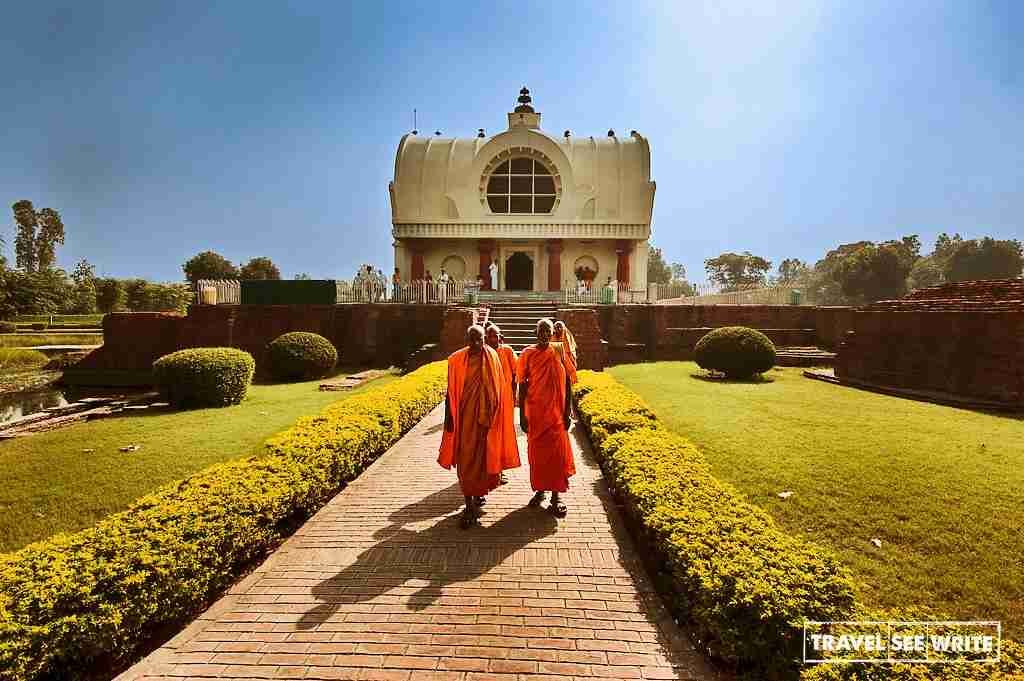
Now, Kushinagar may not be as well-known as Lumbini or Bodhgaya, but let me tell you, it’s a hidden gem of Buddhist heritage. This holy place of pilgrimage for Buddhists holds immense religious and historical significance as it is the sacred site where Lord Buddha is said to have taken his last breath and achieved ‘Mahaparinirvana’, breaking free from the cycle of rebirths. Culturally, Kushinagar is a living testament to Buddhist traditions, attracting monks, scholars, and pilgrims from worldwide. What sets this town apart is its peaceful atmosphere and profound spiritual heritage. Despite not being in the spotlight, the charm of Kushinagar lies in its simplicity and deep spiritual resonance.
While exploring the sleepy town, I was intrigued to learn the old name Kushinagar. I met an old Buddhist who stayed in the monk’s quarters and was patient enough to talk to me. He explained,
Kushinagar, in the olden days, was known as Kushavati and later as Kusinara.
While talking to him and exploring the old sites, I realised that these ancient names reflect the town’s deep-rooted importance in Buddhist lore and its long-standing spiritual legacy.
I reached my destination around 11 am. It was blistering hot, and the mercury was touching 45 degrees Celsius. Despite the heat, I could cover the city’s major attractions. Here is a list of must-visit places in Kushinagar.
What to See and Do in Kushinagar: Must-Visit Sites
Kushinagar is home to several sacred sites that are visually stunning and spiritually enriching. The monuments here are clustered in three groups: 1) the Mahaprinirvana site, the central Stupa, and the surrounding monasteries, 2) Mathakuar Kot, and 3) the Ramabhar Stupa.
Mahaparinirvana Temple, Kushinagar
Walking through a Buddhist monastery, I arrived at one of Kushinagar’s biggest draws—the Parinirvana Stupa or Mahaparinirvana Temple. This ancient temple is revered by Buddhists worldwide because historical records indicate that Gautam Buddha attained liberation from the cycle of birth and death at the age of 80 at this location.
Barring a few locals, there were few tourists around. A tiled path snaking through manicured lawns, shaded green trees and scattered ruins of various monasteries brought me to the beige-coloured, revered sacred site of Kushinagar Temple.
Outside the Mahaparinirvana temple were several plaques in different languages with information about the temple. Archaeological evidence from the 3rd century BCE suggests that Kushinagar was an ancient pilgrimage site where King Ashoka built a stupa and placed a pillar to mark Buddha’s attained Mahaparinirvana.
Later, in 1866- 1877, British archaeologist Alexander Cunningham excavated the remains of the main Mahaparinirvana Stupa and the 6.1m reclining Buddha statue dating back to around 637 AD. The reclining statue of Buddha symbolises his peaceful passage into nirvana. The present-day Parinirvana Stupa was reconstructed by the Indian Government in 1956 to mark the 2,500th year of the Mahaparinirvana. The Parinirvana Stupa’s height is 65 feet (19.8 meters). Surrounding the Stupa, visitors can meditate or explore the compound’s numerous historical artefacts and sculptures.
When you look closely at the Parinirvana Temple, you’ll realise it is built in a traditional Buddhist style. Walking up the brick stairs, you enter a room with a 6.1m long reclining Buddha statue carved from a single sandstone block. The statue displays Lord Buddha reclining on his right side, looking towards the west, in a meditation pose, symbolising his state as he entered Mahaparinirvana. Daily, followers come together to present their prayers and meditate, particularly those travelling the Buddhist Pilgrimage Circuit. The site is vivacious during Buddha Purnima, or Buddha’s birthday celebration in May.
The Mahaparinirvana temple is a place of spiritual and religious significance. Still, it also holds immense archaeological value, showcasing ancient artefacts and remnants of Buddhism’s rich cultural heritage. However, it was only sometimes this way. Initially, the temple lay in complete ruins, with the Buddha sculpture and the entire structure shattered. Thanks to the efforts of the Indian Government, it was restored to its former glory in 1956. Even today, the main temple is surrounded by the remnants of ancient stupas.
After spending half an hour at the Stupa, I walked to the nearby Burmese Japanese Golden Stupa.
Burmese Temple / Japanese Golden Stupa, Kushinagar
Popularly known as the Burmese Temple or Golden Stupa by the locals, this Japanese temple is one of the unique structures and is among the most-visited tourist destinations in Kushinagar. The temple is a marvel of Buddhist architectural grandeur of modern times and is the tallest Buddhist structure in Kushinagar. The Atago Isshin World Buddhist Cultural Association built this Kushinagar temple, which was generously funded by the Japanese monarchy.
The statue was originally brought from Japan in a dismantled form and was finally given shape here. Life-size statues of monks and religious luminaries add to the temple complex’s overall spiritual atmosphere. Unfortunately, the circular chamber of the Golden Stupa was closed, so I couldn’t see it from inside. Still, I did my parikrama around the Stupa. The 13-year-old kid who runs a snacks-cum-souvenir shop outside the temple said,
Didi aap Janauary mein aana yahan. Tab bahut bada mela lagta hai.
Sri Lanka Japanese Buddhist Temple of Kushinagar
Sri Lanka Japanese Temple is another Buddhist Temple designed and built by the Atago Isshin World Buddhist Cultural Association in Kushinagar. Like the Burmese Temple, the Japanese monarchy bore the cost. As you enter the gate and cross the lawn, a flight of stairs leads to the main shrine, a brick dome structure.
Although the Indo-Japanese-Srilankan Temple apparently indicates the cooperation of the Buddhist devotees from the three countries in the construction, the fact, however, is that the famous Ashta Dhatu, or an eight-metal alloy idol of the Buddha installed in it, was imported from Japan. It was in two pieces when it was brought to Kushinagar and assembled into its present form at the temple.
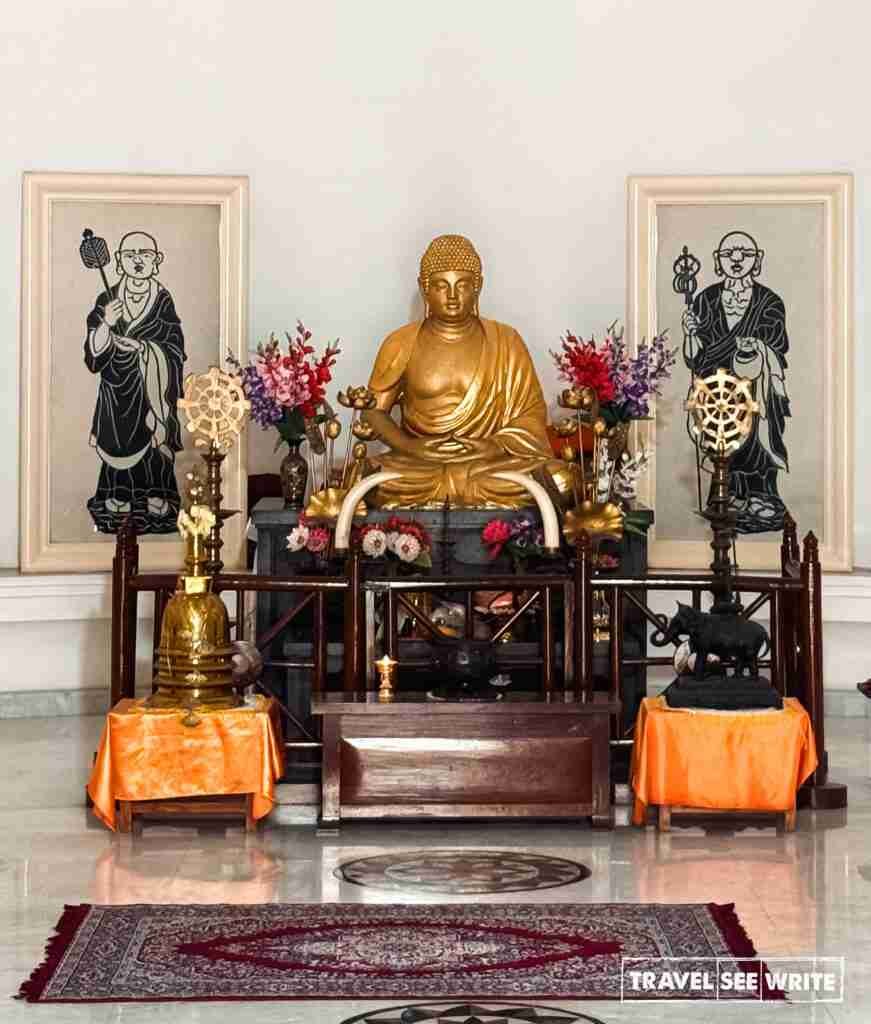
The ash of the Buddha’s idol has been placed in a magnificent circular chamber in the temple. Soft light filtering from the stained glass windows falls upon the idol, giving it a unique spiritual radiance and peaceful ambience. The Buddha’s statue is flanked by portraits of his ten main bhikus crafted in Japanese style.
Wat Thai Temple, Kushinagar
Another must-see Kushinagar temple is the Wat Thai Kushinara Chalermaraj Temple, also known as Wat Thai Temple by Buddhists. It was constructed to honour the fiftieth anniversary of King Bhumibol Adulyadej’s ascension to the throne of Thailand. Somdej Phra Yansangvara, the highest Patriarch of Thailand, started building the temple on 21 February 1999. It was finished and made accessible to the public in 2001. The funds for its creation were mainly collected through donations from Thai Buddhists.
The temple was initially conceived as a forest monastery located amongst dense growth of various trees, shrubs, and plants. Built in the Thai-Buddhist architectural style, it is located in a vast complex sprawling over ten acres with serene gardens, providing a peaceful retreat for meditation and reflection.
Besides the temple, the complex also houses a monastery, garden, health centre, school, and library. It is one of Kushinagar’s most beautiful tourist destinations and is visited particularly by thousands of pilgrims from Thailand annually. Its massive structure can be seen from all parts of the city. When I visited, photography wasn’t allowed inside the main temple, and the main temple and garden were closed to visitors.
Ramabhar Stupa, Kushinagar
The ancient Ramabhar Stupa marks Buddha’s cremation site and is a monumental testament to his life and teachings. Its peaceful surroundings make it the perfect place for contemplation and reverence.
Also known as Mukutbandhan-Chaitya or Mukta-Bandhan Vihar in ancient Buddhist texts, Ramabhar Stupa is situated around 1.5 km to the southeast of the Nirvana Temple. The location of the Stupa holds excellent significance for Buddhist pilgrims globally. Buddha was believed to be cremated at this very spot after his passing in 483 BC. According to Buddhist scriptures, the Malla Kings, the rulers of Kushinagar during Buddha’s lifetime, were responsible for constructing the Stupa. The structure’s architectural style serves as evidence of its ancient historical importance. The Stupa is situated on a raised platform facing the Kushinagar-Deoria road and is constructed using bricks. With a circular base measuring 47.24 m, the Stupa stands at a height of 14.9 m. Its drum-shaped upper part has a diameter of 34.14 m. The Stupa is surrounded by agricultural land featuring rice, sugarcane, and wheat fields. Additionally, a pond-like body of water is close to it.
Other Notable Sites in Kushinagar
The Kushinagar Museum
Also referred to as the Buddhist Museum, it is a must-visit attraction in Kushinagar, especially for those interested in exploring the Buddhist heritage and archaeology of the area. Situated near the Tibetan Temple, it is among the most ancient museums in Kushinagar. With a remarkable assortment of ancient artefacts, relics related to Buddha’s teachings, sculptures, and informative displays, the Buddhist Museum provides a comprehensive overview of Buddha’s life and his travels in India, offering a glimpse into the spiritual ambience of Kushinagar and the state of Uttar Pradesh. The museum remains open daily from 10 am to 5 pm, except for Mondays when it remains closed.
15-acre meditation park, Kushinagar
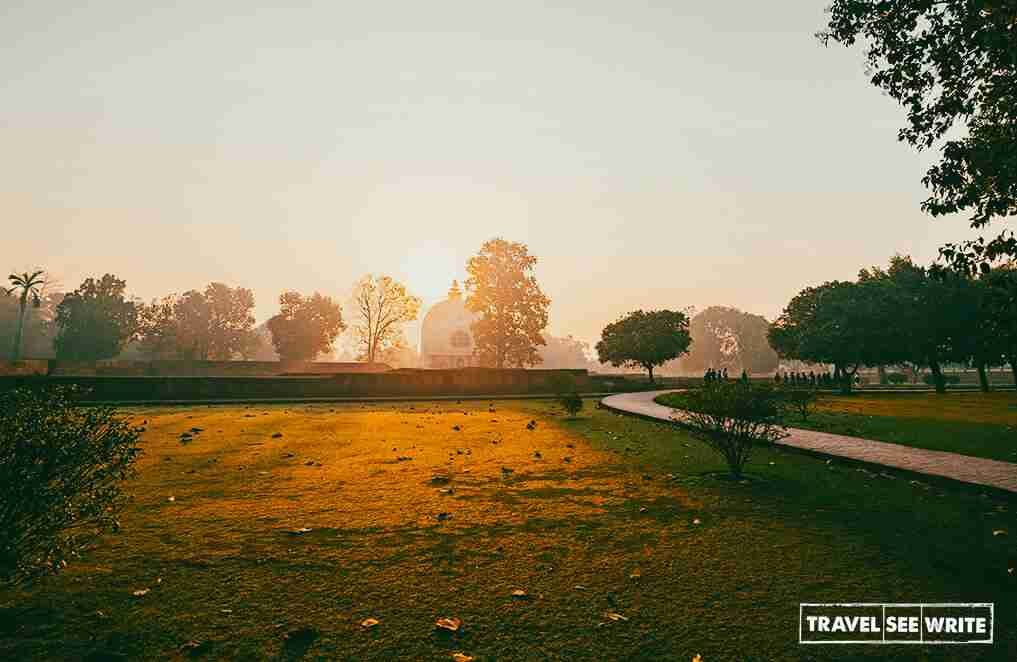
This peaceful park serves as a sanctuary for locals and tourists to meditate and find inner peace. Lush trees, still ponds, and well-kept lawns provide the ideal environment for offering prayers and contemplating Buddha’s wisdom. Often known as the Japanese Meditation Park, this area was developed in the early 1990s as part of a collaborative effort between India and Japan. The park welcomes visitors from 6 am to 6 pm every day.
Matha Kuar Shrine, Kushinagar
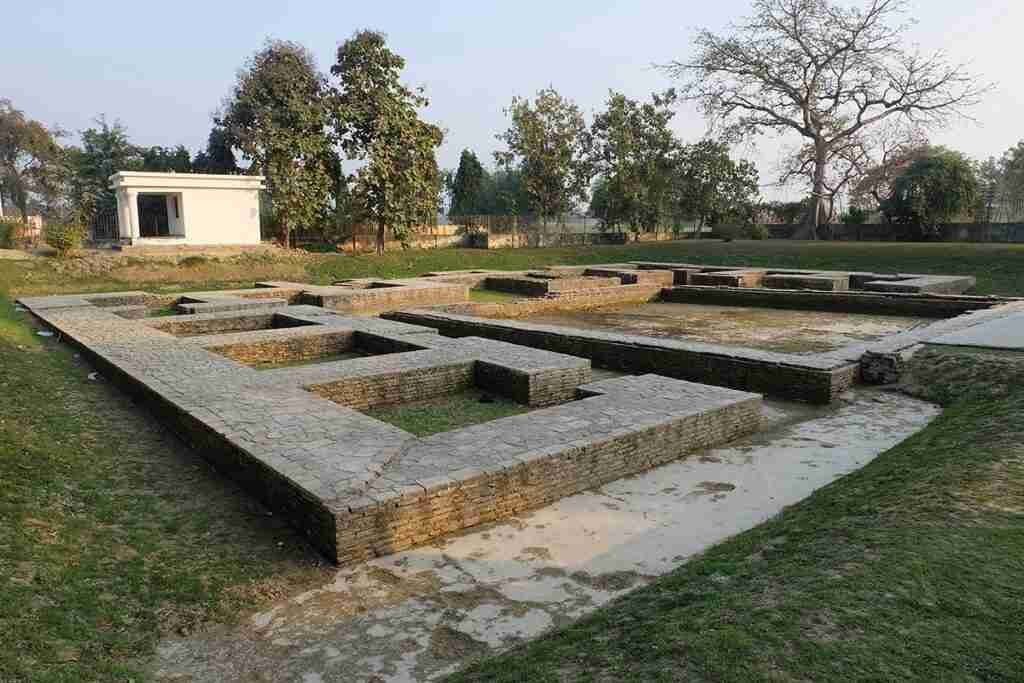
It is a relatively simple and unassuming structure compared to some of the larger Buddhist monuments in Kushinagar. Conveniently located just a short walk from Parinirvana Stupa, this shrine marks where Buddha delivered his final teachings and performed his last human acts, such as drinking water. Inside the shrine is a stone image of Buddha positioned under the Bodhi tree in the Bhumi Sparsha Mudra, also known as the earth-touching position. Despite its smaller size, the site holds great significance for Buddhists travelling on the Buddhist circuit and devotees who wish to contemplate the Buddha’s final teachings.
Birla Temple, Kushinagar
The Temple is a well-known Hindu temple, one of the most recent spiritual sites in the Buddhist pilgrimage town of Kushinagar. It is associated with the Birla Foundation, an organisation committed to promoting literature, especially Hindi literature, and the arts and education. Within the modern and intricately designed temple, visitors will find a marble statue of Lord Shiva in an upright seated position. The temple offers high-quality accommodations and amenities at affordable prices and is open to visitors from all backgrounds. Many devotees from around the globe journey to the Birla Shiva Temple to seek blessings from Lord Shiva.
Chinese Temple, Kushinagar
An exquisite temple reflecting Chinese Buddhist architecture.
Things to Do in Kushinagar
When planning your activities in Kushinagar, allocate time to explore the above significant sites. Each Kushinagar Temple and Stupa offers a unique glimpse into Buddhist traditions and architecture. Also, remember to engage with locals, such as hearing stories and experiences from the residents.
Practical Travel Tips for visiting Kushinagar
कुशीनगर इतना प्रसिद्ध क्यों है?
कुशीनगर अपने अद्वितीय बौद्ध धरोहर के लिए प्रसिद्ध है। भगवान बुद्ध ने यहां अपना अंतिम उपदेश दिया और परिनिर्वाण प्राप्त किया। यह स्थल उन अनगिनत तीर्थयात्रियों के लिए एक महत्वपूर्ण स्थान है जो शांति और मोक्ष की खोज में यहां आते हैं।
How to Reach Kushinagar
Getting to Kushinagar is an adventure, with multiple routes leading to this serene town.
By Air
Although Prime Minister Narendra Modi inaugurated Kushinagar International Airport on 20 October 2021, currently, it doesn’t offer regular local or international flights.
The nearest airport is Gorakhpur Airport, which is well-connected to major Indian cities. From Gorakhpur, it’s a comfortable hour-and-a-half drive to Kushinagar. Other nearby airports to Kushinagar are Lal Bahadur Shastri Babatpur Airport, Varanasi (286 km from Kushinagar) and Chaudhary Charan Singh Airport, Lucknow (352 km from Kushinagar).
By Train
If you prefer the train route, Gorakhpur Junction is the closest major railway station, serving as a hub for trains from all over India. You can hail a local cab or board a bus directly from Kushinagar.
By Road
Now, for all you road trip enthusiasts, let me tell you that Kushinagar is easily accessible via well-maintained roads. Situated on National Highway No. 28, with frequent bus services, it is well connected with other parts of the state. I took a cab from Gorakhpur.
From Delhi to Kushinagar
If you’re travelling from Delhi, you can fly directly to Gorakhpur or to Lucknow and then by road to Kushinagar. Alternatively, trains and buses offer convenient journey options.
From Lucknow to Kushinagar
For those starting their journey from Lucknow, regular trains and buses run to Gorakhpur. From there, it’s just a short drive to Kushinagar.
Some major road distances from Kushinagar are:
Which Language is Spoken in Kushinagar?
So, the main language spoken in Kushinagar is Hindi, the go-to language in Northern India. However, due to the large influx of international pilgrims, you’ll likely hear Pali, English, and other languages spoken in the temples and monasteries.
Where to Stay in Kushinagar: Hotels in Kushinagar
Accommodation in Kushinagar ranges from budget hotels to more comfortable lodgings. Here are some options:
- Royal Residency Kushinagar: A popular choice for pilgrims and tourists.
- Lotus Nikko Hotel: Offers comfortable rooms and modern amenities.
- Buddha Residency: Known for its hospitality and convenient location.
You can find more details about Kushinagar’s food and cuisine and the hotels you should stay at here.
What to Eat in Kushinagar: Local Delicacies
Kushinagar offers a variety of local and traditional foods that will tantalise your taste buds
- Litti Chokha: A traditional dish from Bihar and Eastern Uttar Pradesh.
- Samosas and Pakoras: Popular street snacks.
- Chole Bhature: A hearty meal enjoyed by locals and visitors alike.
- Local Sweets: Treat yourself to Jalebi and Peda.
Best Time to Visit Kushinagar
The best time to visit Kushinagar is during the cooler months, from October to April. Key festivals to experience include:
- New Year Festivals in December – January: Celebrating various aspects of Buddhist culture.
- Buddha Jayanti / Purnima: Celebrated in April/May, marking Buddha’s birth, enlightenment, and death.
Immersing in the Local Experience
One of the highlights of my visit was engaging with the locals. Their stories, deeply rooted in generations of living amidst such spiritual richness, added a profound depth to my experience. I remember a shopkeeper near the Mahaparinirvana Temple who shared tales of pilgrims finding solace and transformation.
Extending the Kushinagar Journey: Where to Go Next
If you’re looking to extend your pilgrimage, several nearby attractions are definitely worth a visit.
A short drive will take you to Kapilavastu and Shravasti. Crossing the border into Nepal will take you to Lumbini, the birthplace of Buddha. And if you want to continue your spiritual journey, Bodhgaya, where Buddha attained enlightenment, is also accessible.
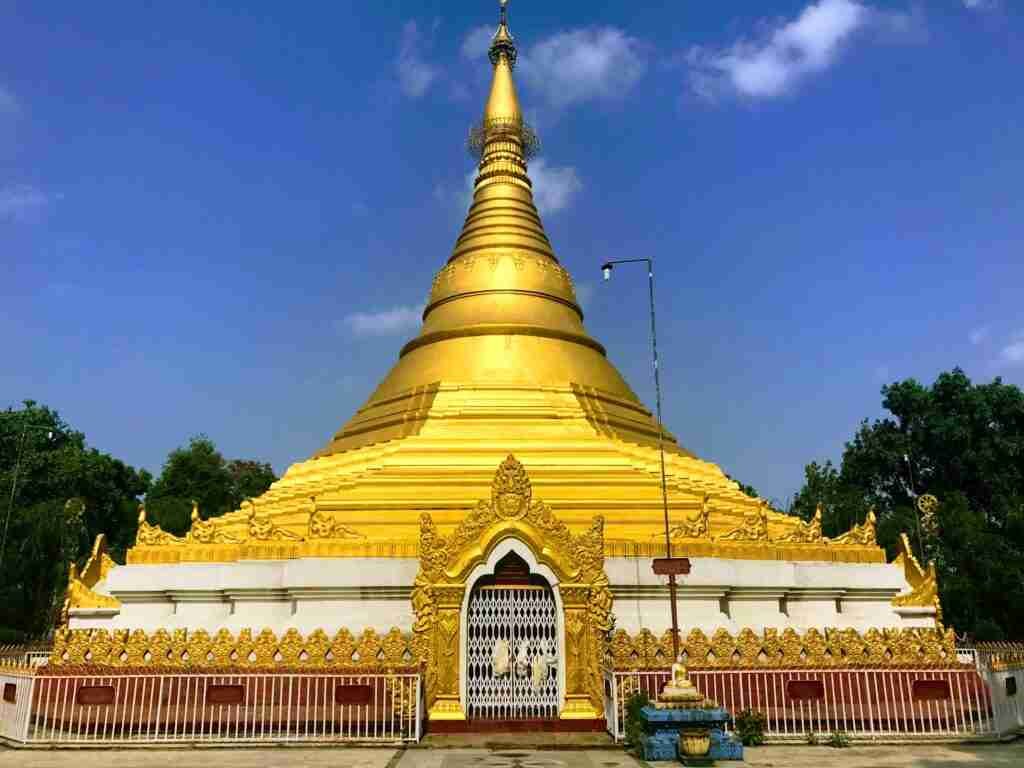
Suggested Buddhist Pilgrimage Circuit Itineraries
If you’re up for it, a typical itinerary could include visiting Varanasi, Sarnath, and Bodhgaya. This way, you’ll explore and experience the significant Buddhist sites in India, creating a comprehensive Buddhist Pilgrimage Circuit.
Let me virtually take you on the Journey of Enlightenment, following in Lord Buddha’s footsteps and discovering the profound spiritual heritage of each destination.
- Lumbini: This is where it all began—the birthplace of Prince Siddharth, where the journey towards enlightenment started.
- Kapilavastu: Take some time to explore the ancient city of Kapilavastu, where Prince Siddharth spent his childhood and youth.
- Bodhgaya: This is the place where Prince Siddharth attained enlightenment under the Bodhi Tree.
- Sarnath: Lord Buddha delivered his first sermon after enlightenment here, igniting the flame of Dharma.
- Kaushambi: This is where Lord Buddha shared his profound teachings, inspiring future generations.
- Shravasti: Lord Buddha spent his monsoon seasons here, spreading his teachings of compassion and wisdom.
- Kushinagar: This is where Lord Buddha attained Mahaparinirvana, transcending the cycle of birth and death.
- Sanchi: A UNESCO World Heritage site with ancient stupas and monasteries showcasing India’s rich Buddhist art and architecture.
- Sankisa: Lord Buddha descended here after addressing his mother in heaven, connecting with the divine energy of the celestial realm.
- Devdah: Here, you can delve into the untold stories of Lord Buddha’s family and their devotion and sacrifice.
Seven of these sacred Buddhist Pilgrimage Circuit sites are located in Uttar Pradesh, India, adding to the state’s spiritual richness. I still have three more destinations to explore, and then my pilgrimage will be complete. How many of these sacred destinations have you had the opportunity to visit? Share your experiences with us!
Conclusion
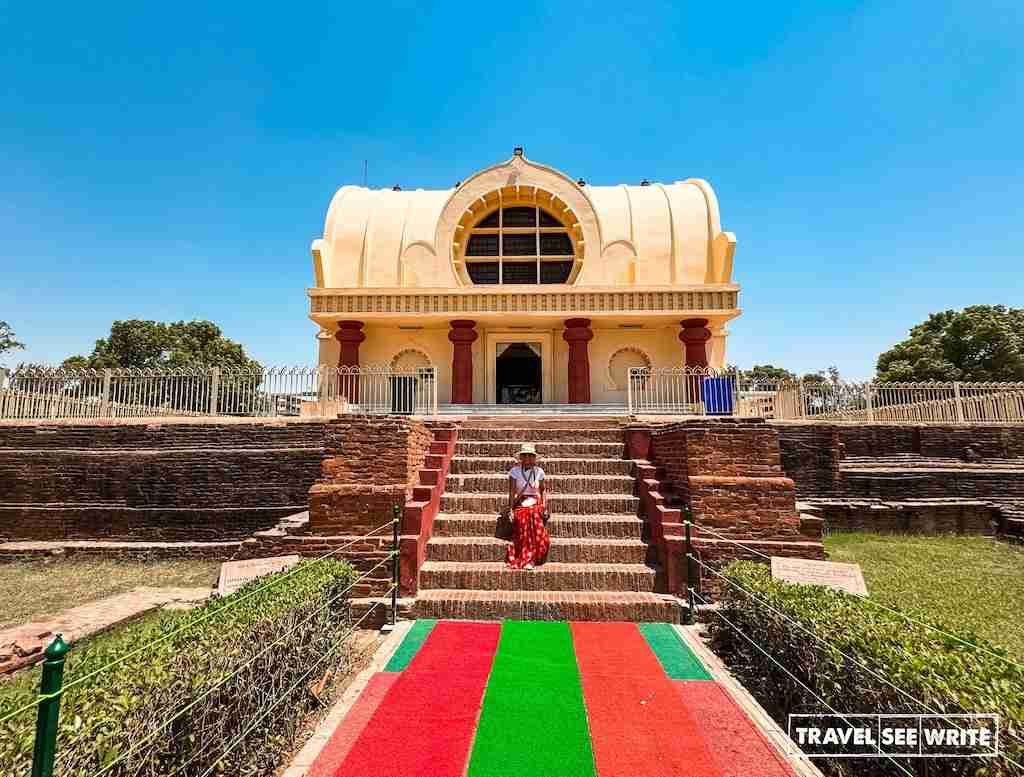
My visit to Kushinagar was more than just a regular trip; it was a pilgrimage that intertwined personal reflection with historical exploration. The town’s serene landscapes and profound spiritual heritage left a lasting impression on me. As I walked the paths once trodden by Buddha, I couldn’t help but feel a deep connection to the timeless quest for liberation and peace. Kushinagar may not be as famous as other Buddhist sites. Still, its quiet charm and profound significance make it a destination every seeker should experience.
Do let me know how you find this Kushinagar Travel Guide and which temples and sights you would be keen to explore on your next visit to this sleepy town of Purvanchal, Uttar Pradesh.

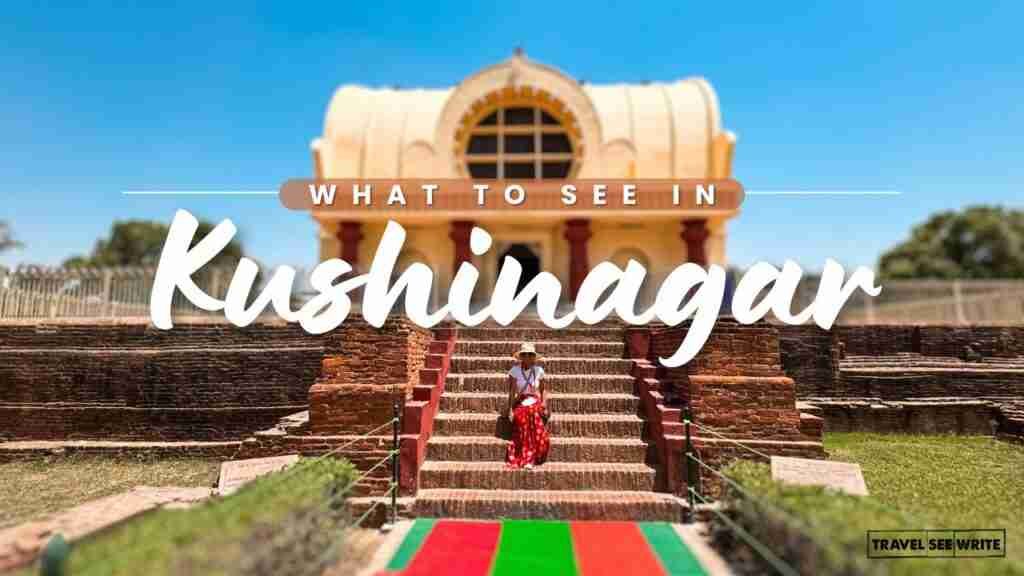

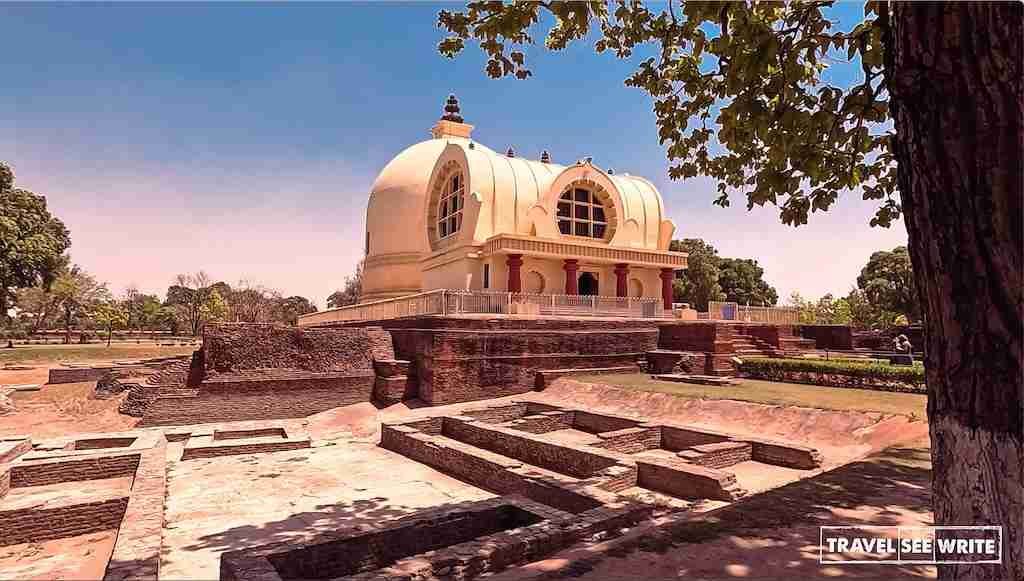
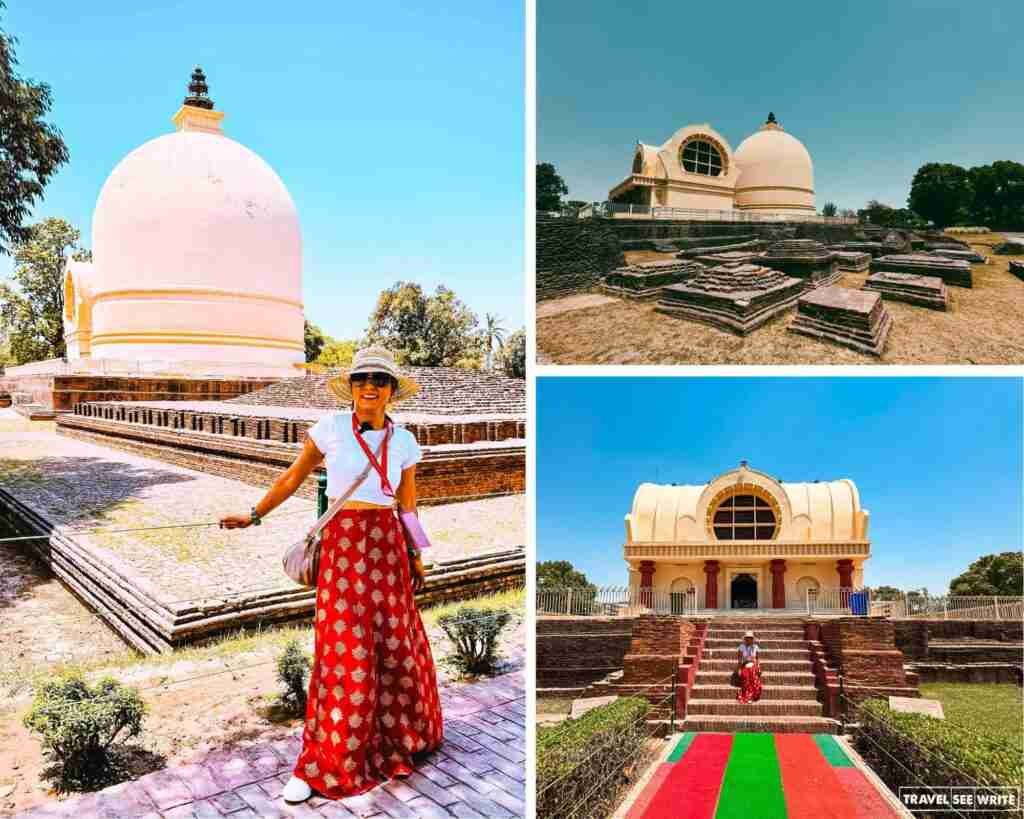
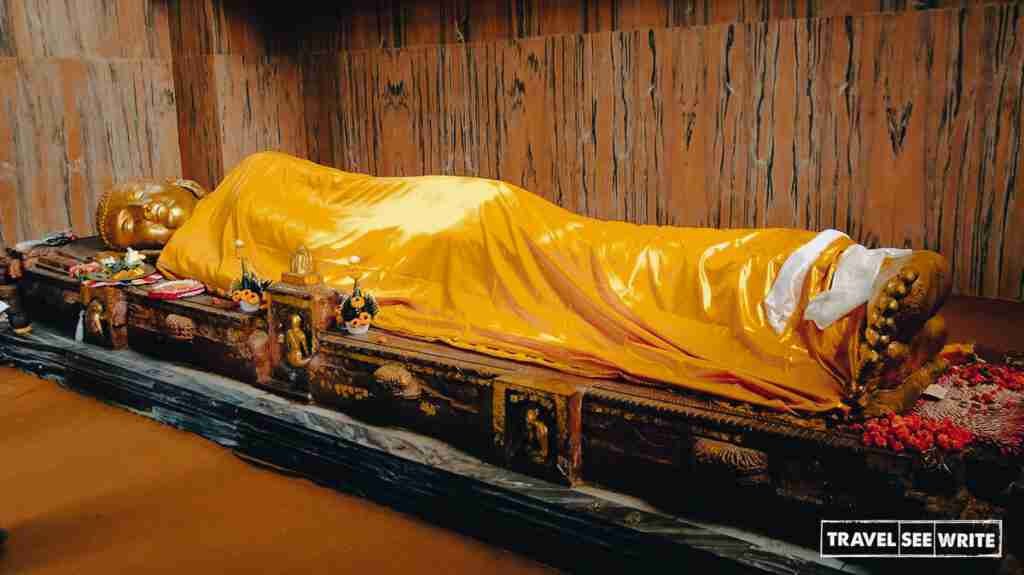

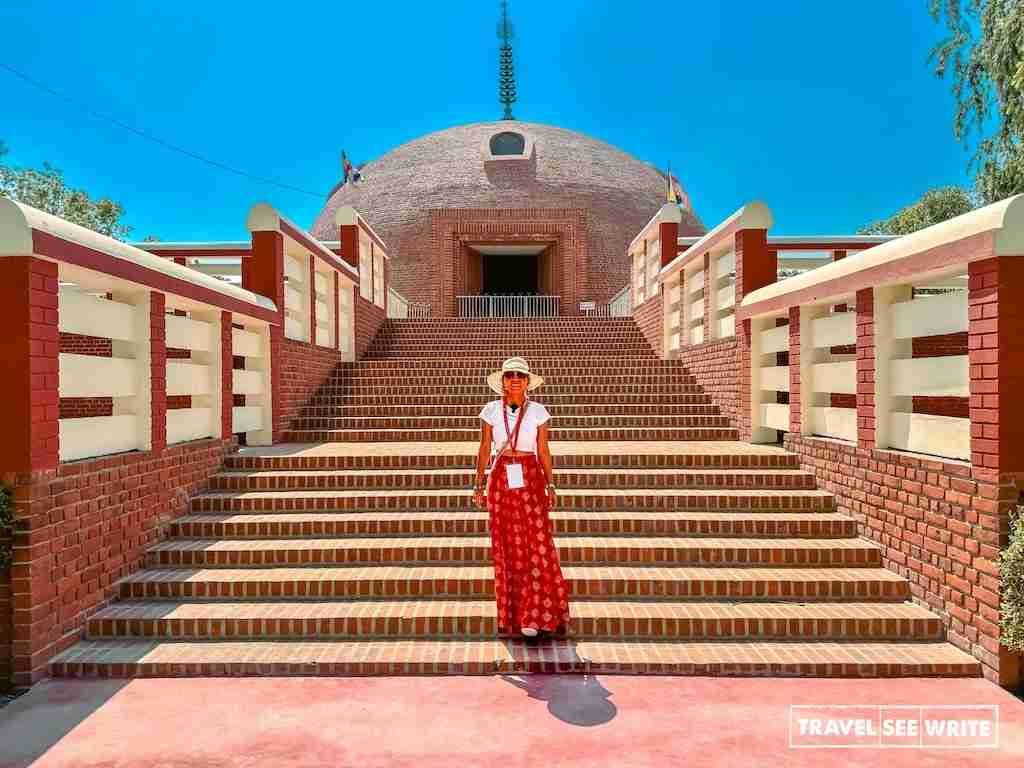

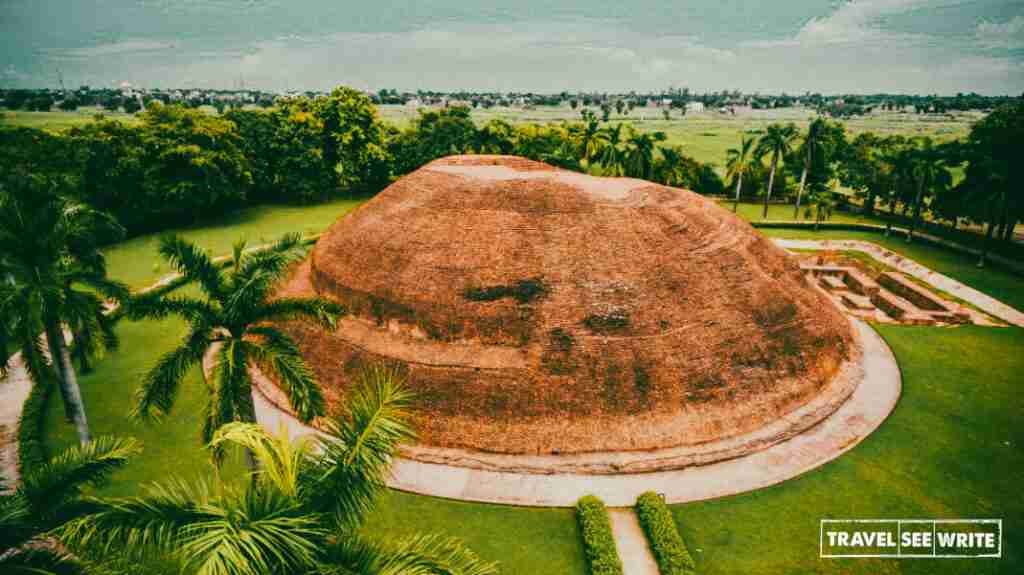
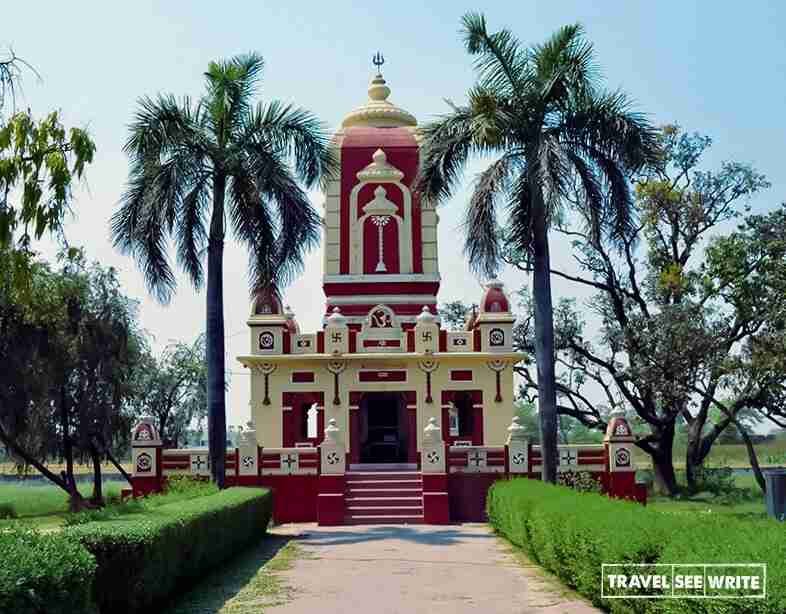

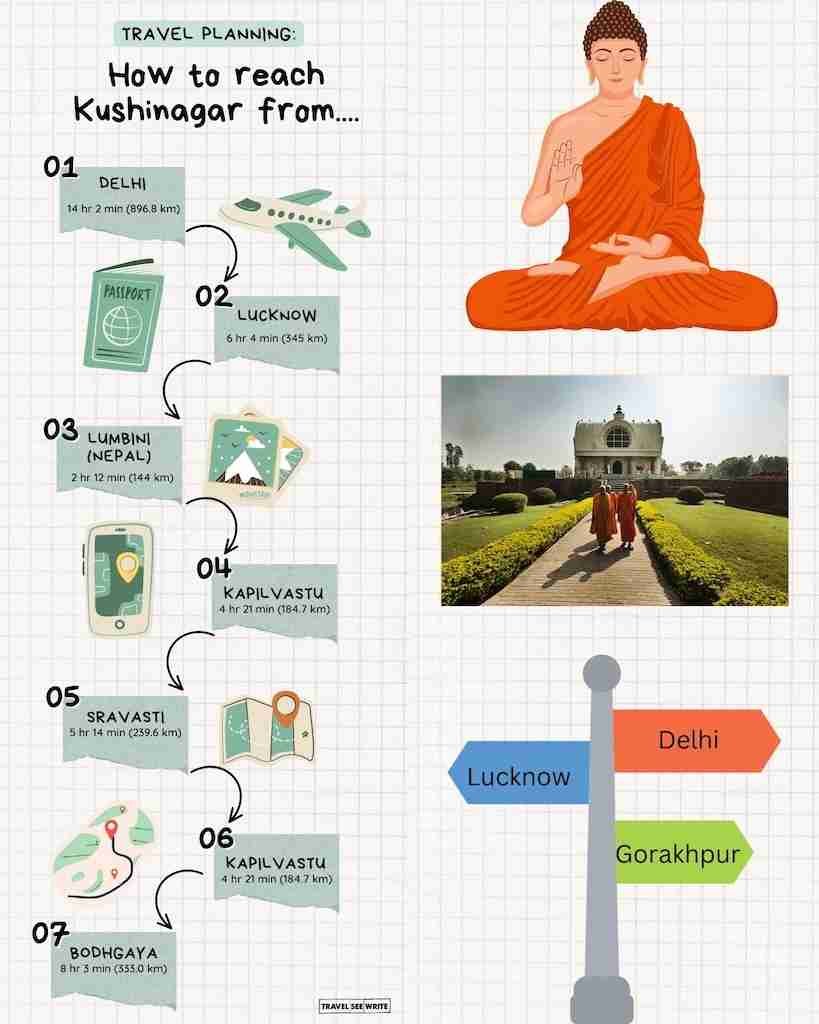




It sounds like you had an incredibly profound journey while visiting Kushinagar! You’ve made me add this to my own travel bucket list, it looks so amazing!
This is absolutely amazing! This guide is a trip through emotions, spirituality, history, and beauty. I’d love to follow it one day.
That’s such a cool trip to go on. Those details are so helpful too.
I wish my visit to Kushinagar would be more than a regular trip like yours. I would love to do a pilgrimage soon.
I had no idea there is so much interesting things to do in Kashmir. Perhaps someday I’ll visit and check it out.
What a captivating travel guide to Kushinagar! Your detailed descriptions and historical insights make this a valuable resource for anyone interested in exploring the footsteps of Buddha.
Temples have always caught my attention with how stunning they are. My family and I have been thinking of visiting to explore the beautiful country. Thank you for all of the tips.
I enjoyed reading about the different temples and sites to visit, like the Mahaparinirvana Temple and the Golden Stupa. I have been to Bali in Indonesia and Thailand, where temples are everywhere. I hope to visit Kushinagar soon.
Great guide to exploring Kushinagar! Love the detailed tips on visiting significant Buddhist sites and local spots. Thanks for sharing!
Take me there now. The way you combined personal reflection with historical exploration shows a deep appreciation for the pilgrimage experience. I would love to explore the serene landscapes and profound spiritual heritage you described. Thank you for sharing your thoughts on this remarkable destination.
Wow, amazing city and first time to know about it. Never been to this side of the planet haha. It’s interesting and look beautiful. Thank you for sharing!
Kushinagar looks like such an ethereal place to visit! All of those famous monuments look gorgeous and definitely worth a trip to see and explore first-hand.